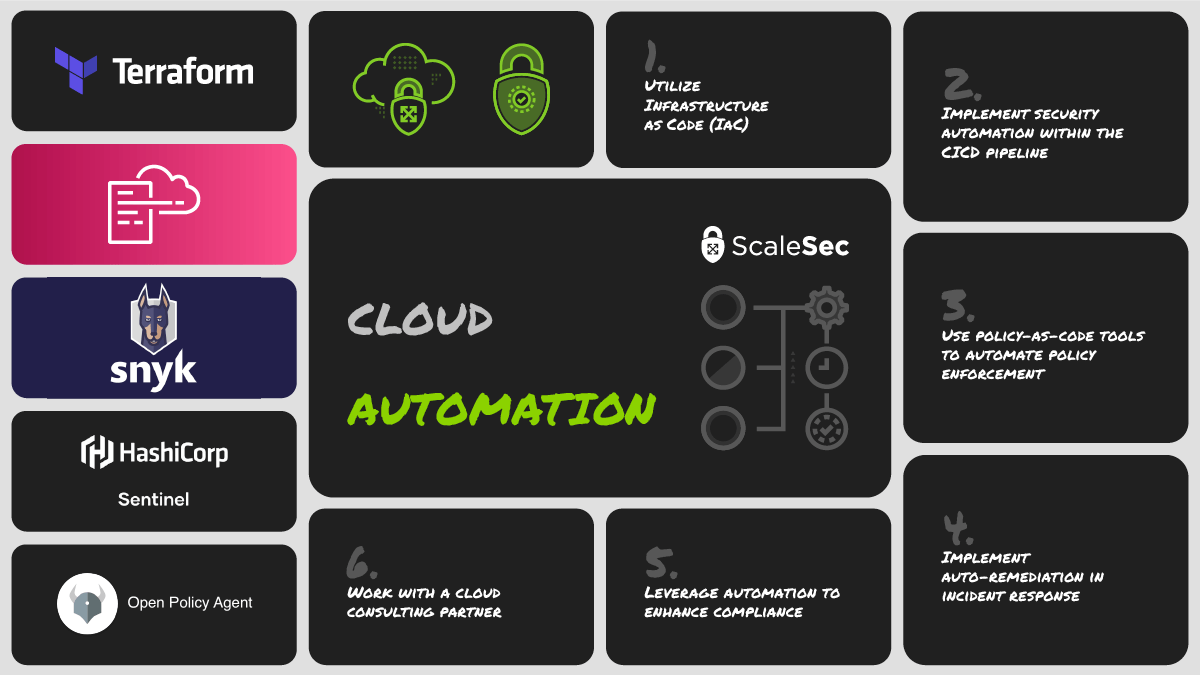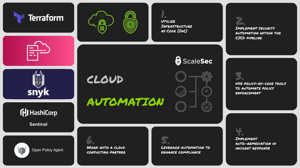
Cloud Automation Tips to Enhance Security & Compliance
Enhance Security and Compliance With These Cloud Automation Tips
Throughout the processes of building and maintaining your cloud environment, there are several areas where automation can be highly beneficial. Understanding cloud automation, the tools available to you, and their applications is crucial for optimizing your operations, security, and compliance measures. Here’s what you need to know.
What Is Cloud Automation?
Cloud automation is the process of automating the management, deployment, and orchestration of resources and applications in your cloud environment. It encompasses a wide array of tools and methodologies that enables organizations to streamline their operations and minimize manual intervention. By effectively harnessing cloud automation, organizations can automate repetitive tasks, build security best practices into their processes, and significantly reduce the likelihood of human error — ultimately leading to a more mature and robust security posture.
The Benefits of Using Cloud Automation
- It saves time, increases productivity, and boosts efficiency: Attempting to maintain cloud environments manually is repetitive, inefficient, and costly. As an organization scales and becomes more complex, automating manual and receptive tasks can free up time, allowing teams to focus on strategic initiatives that drive business growth and acceleration.
- It enhances security and compliance: Cloud automation enables organizations to integrate security and compliance best practices into their processes. Examples include checks to prevent the accidental committing of credentials into source code, or policies to prevent the inadvertently creating a public bucket. Both the AWS Well Architected Framework and Google Cloud Architecture Framework feature cloud automation as a key security best practice.
- It minimizes error: Manually managing security across large-scale cloud environments is impractical and susceptible to errors. Integrating security and compliance best practices into cloud automation capabilities significantly reduces the potential for human error. Furthermore, it is easier to ensure best practices are applied consistently across multiple cloud environments.
- It’s scalable & drives business growth: Cloud automation enables organizations to scale, as well as accommodate business growth and increased complexity. Organizations that leverage cloud security automation gain a competitive advantage by rapidly scaling without compromising secure best practices.
Incorporating cloud automation is an essential component of your cloud security strategy. To fully capitalize on the benefits of cloud automation, it must be implemented effectively and follow security best practices.
Furthermore, cloud security automation is most impactful when it is integrated into various layers of your cloud workflows. The following section explores how cloud automation can be used to enhance security and compliance, with some specific examples from GCP and AWS.
6 Cloud Automation Tips to Enhance Security & Compliance
Wondering how you can take advantage of the cloud automation benefits listed above? Get started with these cloud automation tips from our experts at ScaleSec.
1. Utilize Infrastructure as Code (IaC)
One of the most important steps in leveraging cloud automation is to use IaC tools such as Terraform and CloudFormation to codify your cloud resources. This approach effectively mitigates configuration drift, which is caused by ad-hoc changes. IaC also helps keep your configuration consistent across multiple cloud environments. By developing reusable modules in line with secure baseline standards, IaC builds security into your cloud infrastructure management.
2. Implement security automation within the CICD pipeline
Automation tools can be integrated into your CICD pipeline to identify vulnerabilities and prevent the deployment of insecure configurations. Static Application Security Testing (SAST) tools can be used to identify vulnerabilities in codebases, and linter tools can be used to improve code quality and help identify insecure coding practices.
Snyk is a popular tool that offers all of these features, and there are also a variety of open-source alternatives for achieving robust security automation in your CI/CD process such as tfsec for SAST.
3. Use policy-as-code tools to automate policy enforcement
Solutions such as HashiCorp Sentinel and Open Policy Agent are Policy-as-Code tools used to automate security and compliance checks. These tools enable the enforcement of policies by identifying misconfigured or non-compliant resources prior to deployment. Utilizing this approach enables your organization to proactively integrate security and compliance checks earlier in the development process.
4. Implement auto-remediation in incident response
It is not always possible to catch misconfigurations early, and cloud automation can be used to remediate misconfigured items post-deployment. Both AWS and GCP offer event-driven capabilities.
For example, in AWS a monitoring alert or the creation of a misconfigured item can be captured in AWS EventBridge, which can trigger a custom AWS Lambda function to remediate the AWS resource.
Likewise, event driven auto remediation can be implemented in GCP using Cloud Functions, as illustrated by this informative ScaleSec blog post. Additionally, there are third-party multi-cloud tools like Prisma Cloud, which offer automated remediation capabilities.
5. Leverage automation to enhance compliance
The above-mentioned cloud automation techniques not only strengthen your security posture but also facilitate alignment with specific compliance frameworks. GCP’s Security Command Center offers a comprehensive dashboard for monitoring security and compliance.
Similarly, AWS Security Hub and AWS Config provide visibility into security and compliance oversight. AWS Security Hub features a centralized dashboard displaying compliance checks, and AWS Config provides numerous AWS CloudFormation conformance packs that map Config rules to compliance standards.
6. Work with a cloud consulting partner
Cloud automation streamlines security processes and should be a key pillar of a cybersecurity strategy. However, implementing cloud automation properly requires a substantial investment of time, resources, and expertise, which can be intimidating for those new to the process. Consider collaborating with a cloud consulting partner who can provide guidance on how to effectively implement cloud automation strategies to bolster security and compliance.
If you’re ready to make cloud automation work for your organization, ScaleSec is here to help. Get in touch with one of our cloud experts today.

